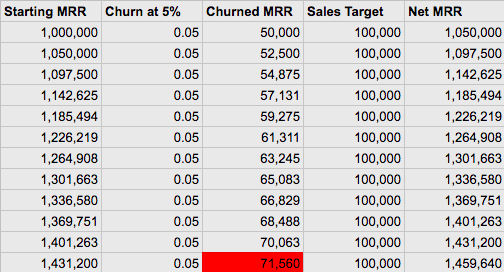Churn. It’s a number that can help make or break your company. That may sound dramatic but it’s true and you are better off facing the cold hard reality of a high churn rate before it’s too late.
While churn is a fact of life in SaaS and it’s inevitable that some customers will leave your company at some point, it does not mean that it’s a metric to be taken for granted. A seemingly low percentage of churn can have a detrimental impact on your company over the long haul. On the flip side, an acceptable churn level, or better yet, negative churn, can give your company a huge boost in value.
When high churn isn’t addressed it can start to have a compounding effect on your overall bottom line. Let’s look at how*:
Let’s say your revenue is $1,000,000 in MRR at the beginning of your fiscal year and your churn rate is at 5%. Here is the financial impact in month one:
1,000,000 x .05 = $50,000
Now let’s also say that your sales team has a target of $100,000 new MRR per month. The table below shows how much money you lose each month and the compounding effect of that 5% churn:
There are a lot of numbers here but I want you to pay attention to the number highlighted in red. In this example, your churn rate has stayed the same but the dollar value has increased exponentially. That’s a $21,650 difference from month one to month 12 for anyone who is counting. Think about the ways this money could be invested back into your organization had it not been lost.*Disclaimer* – This is an extremely simplified way of looking at SaaS churn. There are different ways to measure churn, as discussed in a previous post, and the math can get a bit more complicated. However, we wanted to keep the example straight forward to get our point across of churns negative long term impact.
One last sobering point. Think about sustaining that churn percentage at $2,500,000 MRR and $5,000,000 MRR. That’s $125,000 MRR and $250,000 MRR lost respectively. Get your churn down to 2% and you are looking at $50,000 to $100,000 churned MRR with a lot less terrifying of a compounding factor. Better yet, get to negative churn and have your customer base adding revenue at a higher rate than they are leaving. Now you are laughing.
However, knowing your churn rate is just one part of the battle. It’s knowing the causes of churn that will help you identify what is driving your customers into the arms of your eager competitors. Once you know why you can start to take action to reverse the trend.
Drivers of Churn
Low Product Adoption
If your customers are not using your product extensively, or even worse, not using it at all then you have a churn risk on your hands. It’s important to look at product usage across your customer base and track whether it’s increasing or decreasing. Look for trends so you can put a plan in place to increase product usage.
Selling to the Wrong Customers
Bringing customers on that are not a good product-market fit generally leads to churn. If you are selling to customers that are looking for outcomes your product does not have the capability to deliver then it’s inevitable these customers will churn as they do not receive any value.
Ineffective Onboarding / No Onboarding
An effective onboarding program will be focused on getting customers to first time to value as quickly as possible. If your onboarding program does not provide prescriptive and clear steps that will help customers adopt your product and get your customers using it correctly then you’re increasing the likelihood of customer attrition.
Poor Customer Service
If your customers find it too difficult to get the help they need they’ll simply look for a new solution and leave. Poor customer service could be based on a number of factors such as slow response time, inaccurate information provided, unresolved bugs and support tickets, lack of ongoing customer success, outdated training content, just to name a few. These types of experiences put an obstacle in the customer’s path towards achieving their goals and outcomes. If their outcomes are too hard to achieve then customers will find an alternative solution or stick with the status quo.
Poor User Experience
A poor user experience could be attributed to a number of things. Common reasons include a difficult to learn tool that is not intuitive, product bugs, poor performance (ie your site or app is slow), unnecessary complexity to perform tasks and too many workarounds. Users will lose confidence and patience with your product very quickly if they encounter any of these issues, especially during their onboarding.
Lack of Ongoing Customer Success
If customers do not feel that they have a relationship with your company and that there is a lack of ongoing customer enablement then they may grow complacent or frustrated. Not having a customer engagement framework that promotes ongoing product adoption and relationship building could lead to customers feeling dissatisfied, develop a perception that they are outgrowing your product, or that they aren’t listened to. As a result will feel no particular loyalty to your brand. If a competitor reaches out to your customers they could easily be enticed to make the switch.
Lack of Customer Education
A sound customer education strategy will help to drive product adoption throughout the customer lifecycle. Whether it’s content that helps customers onboard, become mature users or to help learn and adopt new features, an education strategy will help drive continued product usage.
Lack of Relationships
Building relationships is a corner stone of customer success. When customers feel that they have a relationship with your brand and Customer Success team they feel that they have a trusted source to go to for guidance on difficult problems and an advisor for industry and product best practices. They will feel like they are in a partnership with your organization where they can provide valuable product feedback, participate in user groups and case studies. They will have continued confidence that your product will continue to deliver on the goals and outcomes they require.
Loss of Key Contact
If you only have one key contact and they leave the organization then you could end up in a situation where you have to re-sell your solution. Ensure your Customer Success Managers are focused on the breadth and depth of their relationships within their accounts. It’s also worth considering having an executive sponsor program with clients where appropriate. This can be a team effort, not a solo CSM mission.
Not Achieving their Goals and Required Outcome
If a customer is not achieving their required outcomes they will leave eventually. No matter how much they like their CSM or your brand they will not become loyal if they can’t achieve their goals. In all likelihood, the decision maker and champions have performance goals tied to the outcomes of your product. If they are at risk for not meeting their goals because your product isn’t delivering then you should consider them as a churn risk for your company. Understand what factors above are contributing to customers not achieving their outcomes and have a plan in place to address it. Further to that, once you identify reasons and trends for customers not achieving their outcomes make adjustments to your customer engagement framework that will allow your CSMs to proactively prevent these issues from happening in the first place.
At the end of the day your customer buys a product and expects it to work. The better it works and the more intuitive it is, the fewer frustrations they will have. It also means the less help and support they will need. Relationships and the entire customer experience help secure brand loyalty and promote continued product adoption. The combination of a properly working product and a relationship with your company results in retention, growth & expansion sales, loyalty, and advocacy.
To start retaining more of your customers, evaluate what the drivers of churn are within your company. If you aren’t sure where to start, get in touch. We’re experienced in helping organizations uncover their drivers of churn. We can help.
Need help with churn metrics?
Download our Customer Success Metrics Infographic here.





